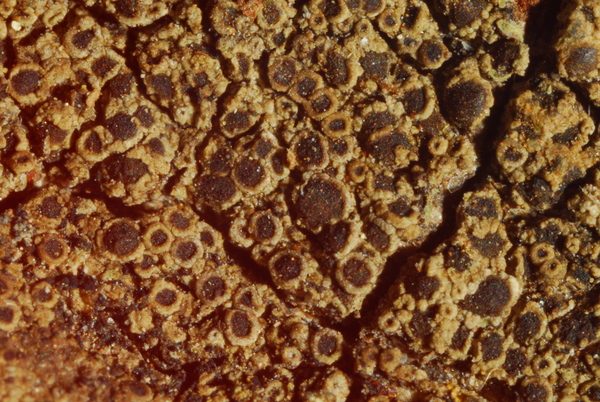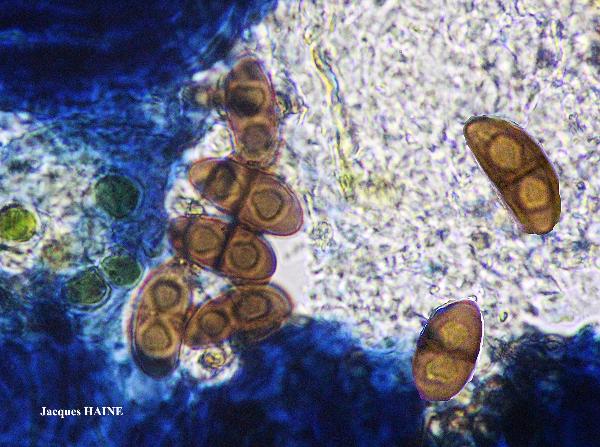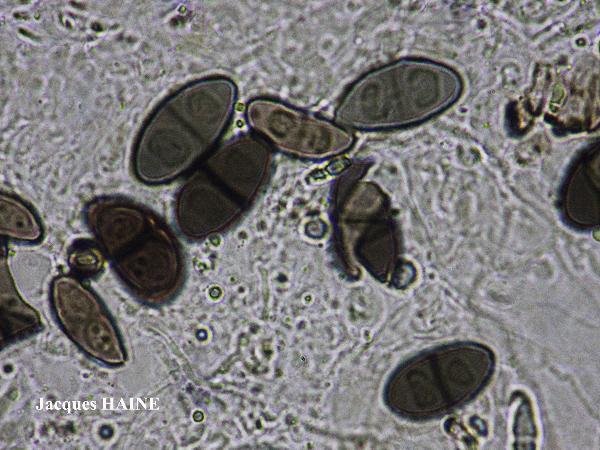Rinodina roboris (Nyl.) Arnold
Flora, 64: 197, 1881. Basionym: Lecanora sophodes var. roboris Dufour ex Nyl. in Crouan & Crouan - Florule Finistère: 96, 1867.
Synonyms: Lecanora roboris (Nyl.) Nyl.; Rinodina metabolica var. roboris (Nyl.) Bagl. & Carestia
Distribution: N - Lomb, Piem (Isocrono & al. 2004). C - Laz (Giralt & Mayrhofer 1994, Bartoli & al. 1997, Massari & Ravera 2002), Sar (Zedda 2002, 2002b, Rizzi & al. 2011, Di Nuzzo & al. 2022). S - Camp, Cal (Puntillo 1995, 1996).
Description: Thallus crustose, episubstratic, usually thick, continuous or irregularly cracked, uneven-granular, grey-white, pale grey to glaucous green-grey, rarely delimited by a dark prothallus. Apothecia lecanorine, sessile, (0.5-)0.8-1.6 mm across, with a dark brown to black, concave to slightly convex, rough disc, and a thick, persistent, often crenulate thalline margin. Thalline exciple 60-70 µm wide laterally, expanding to 80-100 µm in lower part, corticate; proper exciple colourless, c. 5 µm wide laterally, expanding to 20-25 µm in upper part; epithecium dark brown, K-; hymenium colourless, 70-120 µm high, I+ blue; paraphyses coherent, 1.5-2.5 µm thick at mid-level, the apical cells 3-5.5 µm wide; hypothecium colourless or pale yellowish brown, 80-150(-175) µm high, I-. Asci 8-spored, clavate, the K/I+ blue tholus penetrated by a faintly amyloid apical cushion with parallel or diverging flanks, the wall K/I-, surrounded by a K/I+ blue outer layer, Lecanora-type. Ascospores 1-septate, brown, ellipsoid, (14-)18-22(-24) x (7-)9-11(-13) µm, Pachysporaria-type, the lumina at first polygonal then round, the wall thick, smooth or minutely warted, with a well-developed torus, with ontogeny of type A (apical wall thickening after septum formation). Pycnidia immersed, black. Conidia bacilliform, 4-5.5 µm long. Photobiont chlorococcoid. Spot tests: K+ yellow, C-, KC-, P+ faintly yellow. Chemistry: atranorin.Note: a mainly Atlantic species also known from Macaronesia, found on dry bark of ancient, more or less isolated trees, especially oaks, in relatively undisturbed, open, humid woodlands. The record by Bassi (1996) from Emilia is dubious, that from Venezia Giulia by Nimis (1993: 636) is wrong (!). It is included in the Italian red list of epiphytic lichens as “Vulnerable” (Nascimbene & al. 2013c).
Growth form: Crustose
Substrata: bark
Photobiont: green algae other than Trentepohlia
Reproductive strategy: mainly sexual
Most common in areas with a humid-warm climate (e.g. most of Tyrrenian Italy)
In underhangs rarely wetted by rain
Commonnes-rarity: (info)
Alpine belt: absent
Subalpine belt: absent
Oromediterranean belt: absent
Montane belt: absent
Submediterranean belt: extremely rare
Padanian area: absent
Humid submediterranean belt: very rare
Humid mediterranean belt: extremely rare
Dry mediterranean belt: absent
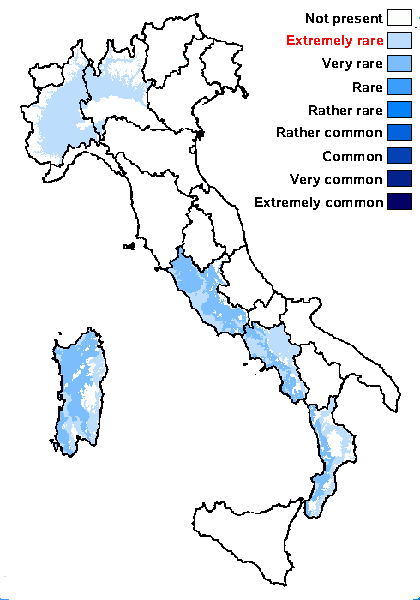
Predictive model
Herbarium samples
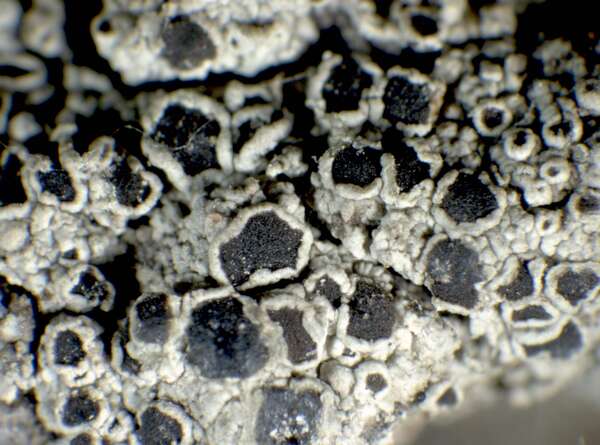

P.L. Nimis; Owner: Department of Life Sciences, University of Trieste
Herbarium: TSB (15343)
2001/11/29
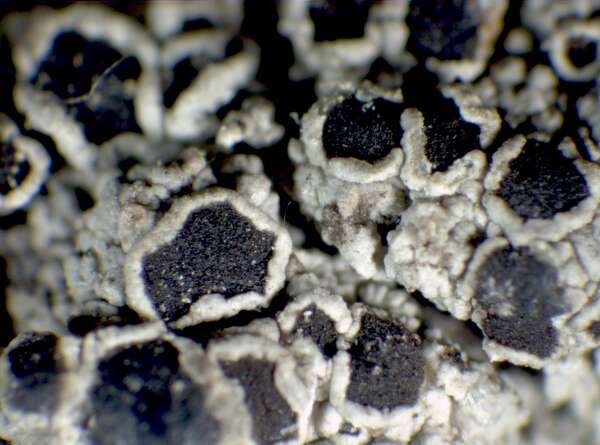

P.L. Nimis; Owner: Department of Life Sciences, University of Trieste
Herbarium: TSB (9416)
2001/11/29
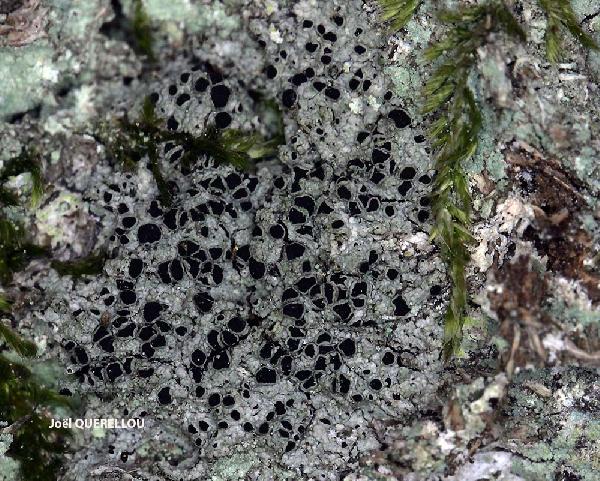
Joël Querellou - Source: http://www.lichensmaritimes.org/index.php?task=fiche&lichen=589&lang=en
France, Brennilis
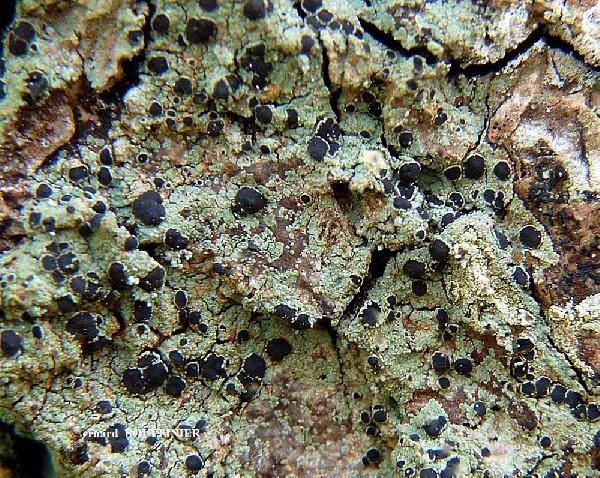
Bernard Bouffinier - Source: http://www.lichensmaritimes.org/index.php?task=fiche&lichen=589&lang=en
France, Aulne
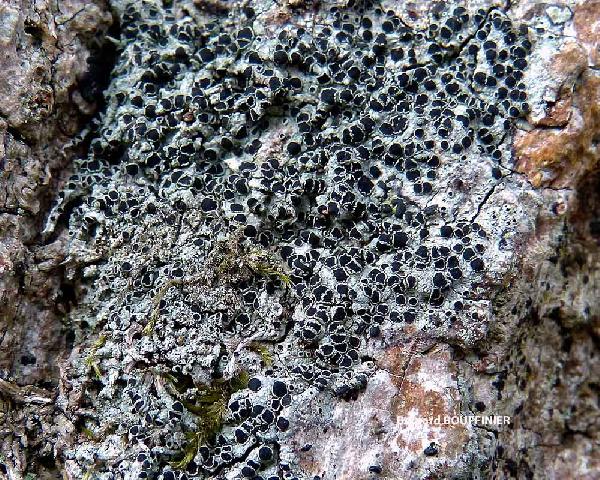
Bernard Bouffinier - Source: http://www.lichensmaritimes.org/index.php?task=fiche&lichen=589&lang=en
France, Brennilis
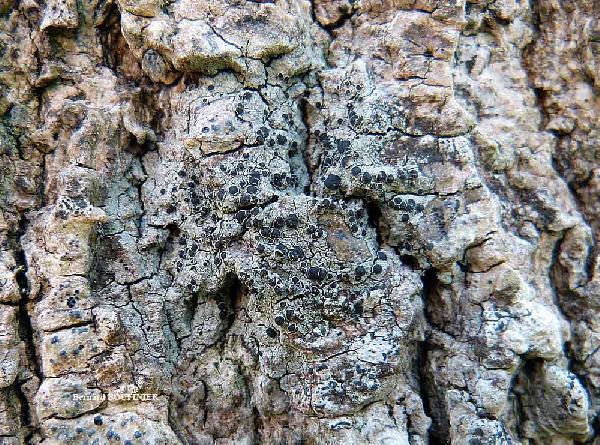
Bernard Bouffinier - Source: http://www.lichensmaritimes.org/index.php?task=fiche&lichen=589&lang=en
France, Crozon
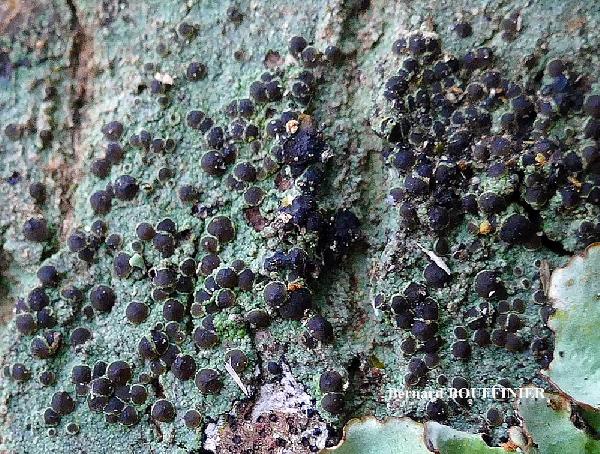
Bernard Bouffinier - Source: http://www.lichensmaritimes.org/index.php?task=fiche&lichen=589&lang=en
France, Crozon

Bernard Bouffinier - Source: http://www.lichensmaritimes.org/index.php?task=fiche&lichen=589&lang=en
France, La Palue
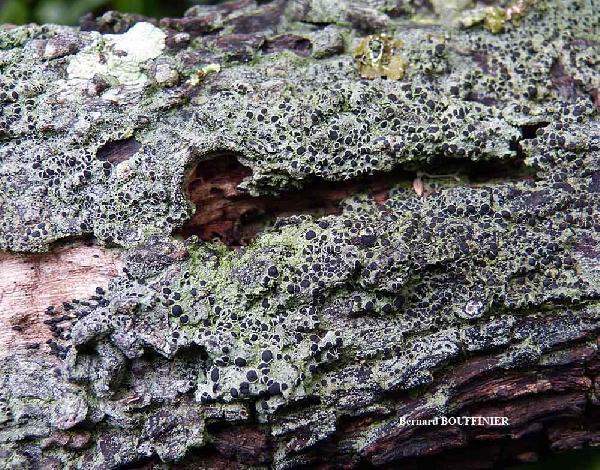
Bernard Bouffinier - Source: http://www.lichensmaritimes.org/index.php?task=fiche&lichen=589&lang=en
France, La Palue
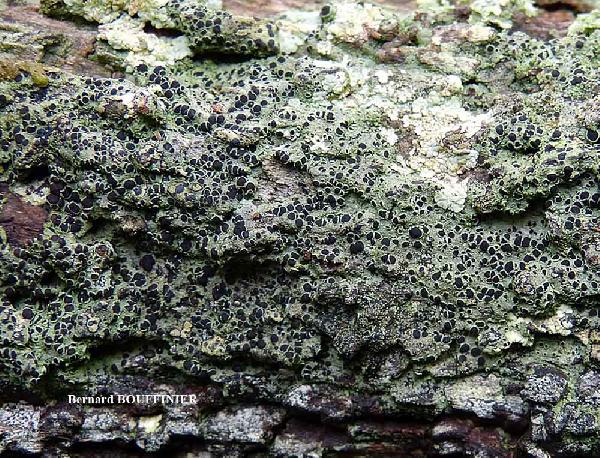
Bernard Bouffinier - Source: http://www.lichensmaritimes.org/index.php?task=fiche&lichen=589&lang=en
France, La Palue
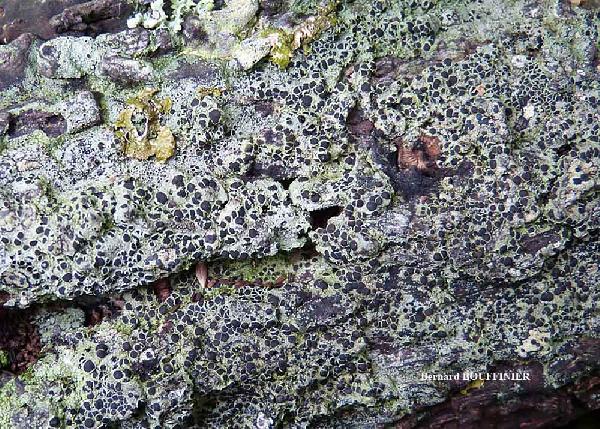
Bernard Bouffinier - Source: http://www.lichensmaritimes.org/index.php?task=fiche&lichen=589&lang=en
France, La Palue

Bernard Bouffinier - Source: http://www.lichensmaritimes.org/index.php?task=fiche&lichen=589&lang=en
France, Landévennec
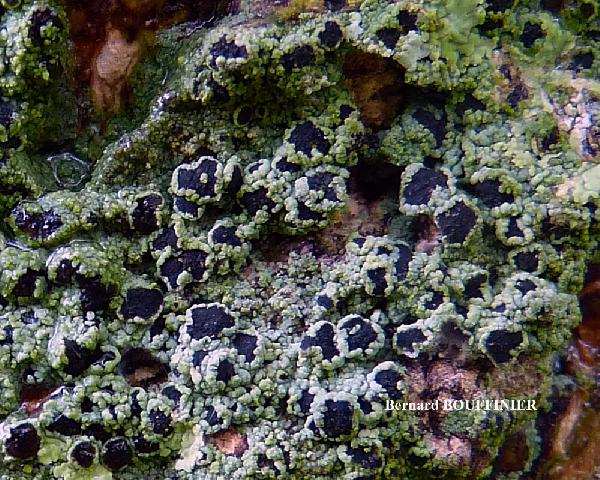
Bernard Bouffinier - Source: http://www.lichensmaritimes.org/index.php?task=fiche&lichen=589&lang=en
France, Landévennec

Jacques Haine - Source: http://www.lichensmaritimes.org/index.php?task=fiche&lichen=589&lang=en
France, Cleden Cap Sizun

Jacques Haine - Source: http://www.lichensmaritimes.org/index.php?task=fiche&lichen=589&lang=en
France, Cleden Cap Sizun
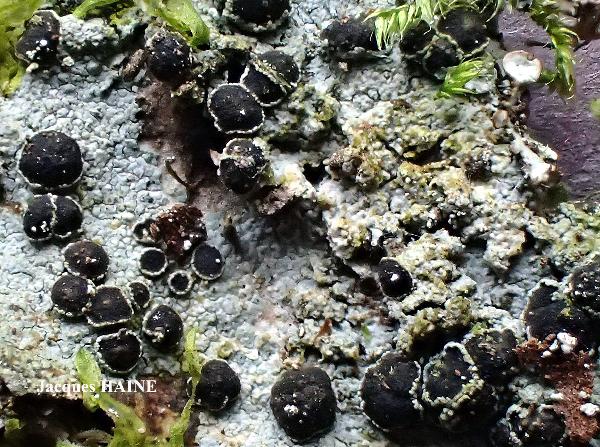
Jacques Haine - Source: http://www.lichensmaritimes.org/index.php?task=fiche&lichen=589&lang=en
France, Cleden Cap Sizun

Jacques Haine - Source: http://www.lichensmaritimes.org/index.php?task=fiche&lichen=589&lang=en
France, Landévennec
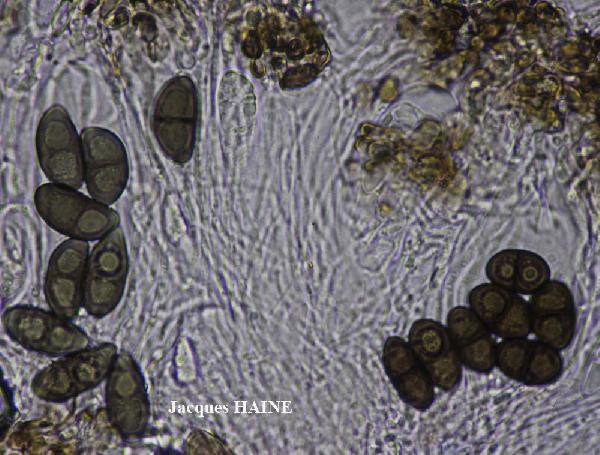
Jacques Haine - Source: http://www.lichensmaritimes.org/index.php?task=fiche&lichen=589&lang=en
France, Landévennec
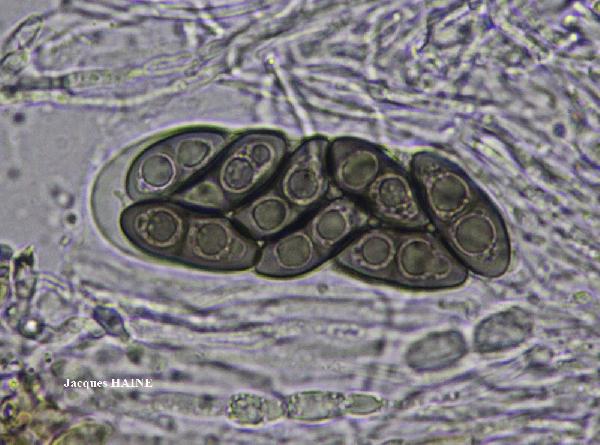
Jacques Haine - Source: http://www.lichensmaritimes.org/index.php?task=fiche&lichen=589&lang=en
France, Landévennec
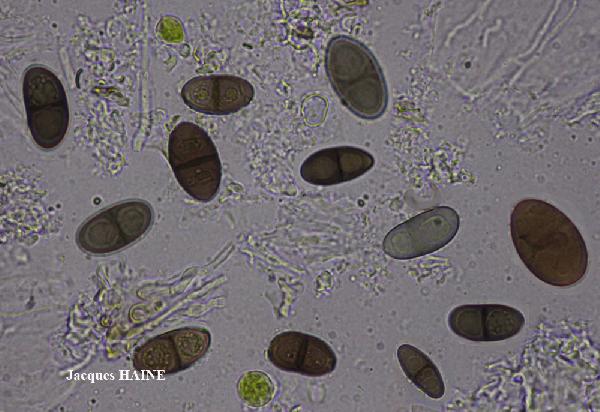
Jacques Haine - Source: http://www.lichensmaritimes.org/index.php?task=fiche&lichen=589&lang=en
France, Landévennec
Growth form: Crustose
Substrata: bark
Photobiont: green algae other than Trentepohlia
Reproductive strategy: mainly sexual
Most common in areas with a humid-warm climate (e.g. most of Tyrrenian Italy)
In underhangs rarely wetted by rain
Commonnes-rarity: (info)
Alpine belt: absent
Subalpine belt: absent
Oromediterranean belt: absent
Montane belt: absent
Submediterranean belt: extremely rare
Padanian area: absent
Humid submediterranean belt: very rare
Humid mediterranean belt: extremely rare
Dry mediterranean belt: absent

Predictive model
| Herbarium samples |


P.L. Nimis; Owner: Department of Life Sciences, University of Trieste
Herbarium: TSB (15343)
2001/11/29


P.L. Nimis; Owner: Department of Life Sciences, University of Trieste
Herbarium: TSB (9416)
2001/11/29

Joël Querellou - Source: http://www.lichensmaritimes.org/index.php?task=fiche&lichen=589&lang=en
France, Brennilis

Bernard Bouffinier - Source: http://www.lichensmaritimes.org/index.php?task=fiche&lichen=589&lang=en
France, Aulne

Bernard Bouffinier - Source: http://www.lichensmaritimes.org/index.php?task=fiche&lichen=589&lang=en
France, Brennilis

Bernard Bouffinier - Source: http://www.lichensmaritimes.org/index.php?task=fiche&lichen=589&lang=en
France, Crozon

Bernard Bouffinier - Source: http://www.lichensmaritimes.org/index.php?task=fiche&lichen=589&lang=en
France, Crozon

Bernard Bouffinier - Source: http://www.lichensmaritimes.org/index.php?task=fiche&lichen=589&lang=en
France, La Palue

Bernard Bouffinier - Source: http://www.lichensmaritimes.org/index.php?task=fiche&lichen=589&lang=en
France, La Palue

Bernard Bouffinier - Source: http://www.lichensmaritimes.org/index.php?task=fiche&lichen=589&lang=en
France, La Palue

Bernard Bouffinier - Source: http://www.lichensmaritimes.org/index.php?task=fiche&lichen=589&lang=en
France, La Palue

Bernard Bouffinier - Source: http://www.lichensmaritimes.org/index.php?task=fiche&lichen=589&lang=en
France, Landévennec

Bernard Bouffinier - Source: http://www.lichensmaritimes.org/index.php?task=fiche&lichen=589&lang=en
France, Landévennec

Jacques Haine - Source: http://www.lichensmaritimes.org/index.php?task=fiche&lichen=589&lang=en
France, Cleden Cap Sizun

Jacques Haine - Source: http://www.lichensmaritimes.org/index.php?task=fiche&lichen=589&lang=en
France, Cleden Cap Sizun

Jacques Haine - Source: http://www.lichensmaritimes.org/index.php?task=fiche&lichen=589&lang=en
France, Cleden Cap Sizun

Jacques Haine - Source: http://www.lichensmaritimes.org/index.php?task=fiche&lichen=589&lang=en
France, Landévennec

Jacques Haine - Source: http://www.lichensmaritimes.org/index.php?task=fiche&lichen=589&lang=en
France, Landévennec

Jacques Haine - Source: http://www.lichensmaritimes.org/index.php?task=fiche&lichen=589&lang=en
France, Landévennec

 Index Fungorum
Index Fungorum
 GBIF
GBIF

